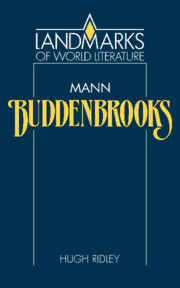Book contents
- Frontmatter
- Contents
- Acknowledgements
- Chronology
- Chronology of Buddenbrooks
- 1 Life and works
- 2 Retrospect on the nineteenth century
- 3 The evolution of the novel
- 4 The theme of decline
- 5 Stages in decline
- 6 Thomas Buddenbrook
- 7 Narrative technique
- 8 The Buddenbrooks' decline: a typical story?
- 9 Literary background and reading public
- 10 Buddenbrooks and the ‘crisis of the novel’
- Suggestions for further reading
2 - Retrospect on the nineteenth century
Published online by Cambridge University Press: 15 December 2009
- Frontmatter
- Contents
- Acknowledgements
- Chronology
- Chronology of Buddenbrooks
- 1 Life and works
- 2 Retrospect on the nineteenth century
- 3 The evolution of the novel
- 4 The theme of decline
- 5 Stages in decline
- 6 Thomas Buddenbrook
- 7 Narrative technique
- 8 The Buddenbrooks' decline: a typical story?
- 9 Literary background and reading public
- 10 Buddenbrooks and the ‘crisis of the novel’
- Suggestions for further reading
Summary
Before we look at the way in which Mann's projected novel came to fruition, it is useful to sketch in the historical situations in which and about which Mann was writing.
The novel opens in 1835 with the Buddenbrooks celebrating their occupancy of the new house. It closes in 1877 with Hanno's death. The actual events from which Mann set out are of later date, since they move back in time from the experiences of the young and adolescent Thomas Mann in the 1890s. The centenary of the Mann family firm took place in 1890, not 1868 as in the novel, and the historical sources Mann used in fact take the action back into the 1820s. He therefore telescopes into forty-two years a rather longer period of family history, and is able to incorporate historical structure into the novel without an excess of historical narration.
By telescoping the action, Mann keeps events within the life of one character, Tony Buddenbrook, who acts as a kind of measuring-rod for the lapse of time and the shift of attitudes. French realists – Mann kept each generation in touch with characteristic historical figures and movements. Johann Buddenbrook represents the Napoleonic period: not accidentally does the dinner discussion in Part One recount the guests' experiences of the great man and his age. His son, the Consul, who disapproves strongly of Napoleon I on moral grounds (1,5), epitomises the quieter values of the post-Napoleonic period.
- Type
- Chapter
- Information
- Mann: Buddenbrooks , pp. 10 - 19Publisher: Cambridge University PressPrint publication year: 1987

